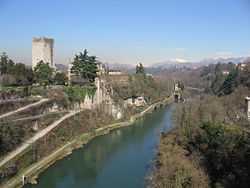Trezzo sull'Adda Bridge
The Trezzo sull'Adda Bridge or Trezzo Bridge was a medieval bridge at Trezzo sull'Adda in Lombardy, Italy, spanning the Adda river. Completed in 1377, the single arch bridge held the record for the largest span for over four hundred years, until the beginnings of the Industrial Age,[1][2][3][4] while it was not until the early 20th century that masonry bridges with larger openings were constructed.[5]
The Trezzo Bridge was built between 1370 and 1377 by order of the lord of Milan Bernabò Visconti.[1] Fortified with towers, it provided access to a Visconti castle high above the Adda.[1] During a siege in 1416, the condottiero Carmagnola deliberately caused the structure to collapse by weakening one of its abutments.[1] Its single arch featured a span of 72 m,[1][2][3][6] according to other sources even as much as 76 m.[7] By comparison, the second largest pre-industrial bridge vault, the French Pont de Vieille-Brioude, spanned nearly 18 m less.[1] The rise of the segmental arch was ca. 21 m, with a span-to-rise ratio of 3.3:1.[1] The arch rip, measured at the springing, was 2.25 m thick,[1] corresponding to a favourable ratio of rib thickness to clear span of only 1/32. The sandstone bridge was almost 9 m wide.[1] Today, the two abutments with overhanging remnants of the arch vault are all that remain.[1]
The Trezzo Bridge was not matched until the metal Wearmouth Bridge of the same span was built at Sunderland, England, in 1796.[8] Longer masonry arch spans were not achieved until the 1903 Adolphe Bridge in Luxembourg.[5]
See also
- Puente del Diablo (Martorell) (37.3 m span)
- Ponte della Maddalena (37.8 m span)
- Puente de San Martín (Toledo) (40 m span)
- Nyons Bridge (40.53 m span)
- Pont du Diable (Céret) (45.45 m span)
- Castelvecchio Bridge (48.7 m span)
- Pont Grand (Tournon-sur-Rhône) (49.2 m span)
- Pont de Vieille-Brioude (54 m span)
- Dyavolski most (56m span)
References
- ↑ 1.0 1.1 1.2 1.3 1.4 1.5 1.6 1.7 1.8 1.9 Hans Straub et al. (1992), p.79f.
- ↑ 2.0 2.1 Donald Hill (1984), p.72
- ↑ 3.0 3.1 Ervan G. Garrison (1999), p.123
- ↑ Leonardo Fernández Troyano (2003), p.93
- ↑ 5.0 5.1 M. G. Lay, James E. Vance (1992), p.268
- ↑ Leonardo Fernández Troyano (2003), p.116
- ↑ Colin O’Connor (1993), p.188
- ↑ Leonardo Fernández Troyano (2003), p.49
Sources
- Colin O’Connor: Roman Bridges, Cambridge University Press, 1993, ISBN 0-521-39326-4
- Donald Hill: A History of Engineering in Classical and Medieval Times, Routledge, 1984, ISBN 978-0-415-15291-4
- Ervan G. Garrison: A History of Engineering and Technology, CRC Press, 1999, ISBN 978-0-8493-9810-0
- Hans Straub et al.: Die Geschichte der Bauingenieurkunst. Ein Überblick von der Antike bis in die Neuzeit, Birkhäuser, 1992, ISBN 978-3-7643-2441-4
- Leonardo Fernández Troyano: Bridge Engineering. A Global Perspective, Thomas Telford Publishing, London 2003, ISBN 0-7277-3215-3
- M. G. Lay, James E. Vance: Ways of the World: A History of the World's Roads and of the Vehicles That Used Them, Rutgers University Press, 1992, ISBN 978-0-8135-2691-1
External links
Coordinates: 45°36′43″N 9°31′24″E / 45.612052°N 9.523202°E
